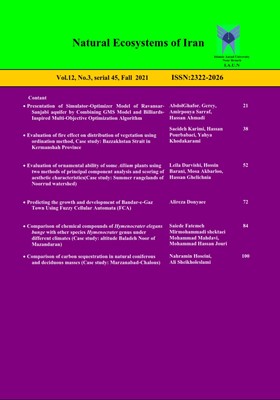Comparison of carbon sequestration in natural coniferous and deciduous stands (Case study: Marzanabad-Chalous)
Subject Areas : forest
Ali Sheykhoeslami
1
*
![]() ,
Naermin Hoseini
2
,
Naermin Hoseini
2
1 - ّForetsry Department, , Chalous Branch,, Islamic Azad University, Chalous, Iran
2 - Forestry Group, Chalous Branch, Islamic Azad University, Chalous, Iran.
Keywords: Carbon sequestration, soil, Climate Change, Forest, Hasnaabad Chalous forests,
Abstract :
Rising greenhouse gases have led to climate change and global warming, which is one of the major challenges in the discussion of sustainable development and has had detrimental effects on human life on Earth. Carbon sequestration in terrestrial ecosystems, such as forests, is the simplest and most economically viable solution to reduce atmospheric carbon. This study is carried out in needles, pure mulberry leaves and broadleaf mixed in Hassanabad Chalous region and the amount of carbon deposited in biomass (leaves and branches), soil (at two depths of 0-15 and 15-30 cm) and litter were estimated. The results showed that the amount of carbon sequestration in each of the needle, leaf and broadleaf masses was 57.184 and 30.222 tons per hectare, respectively, whose economic value was calculated as $ 11437 and 60445 per hectare, respectively. The results showed that the amount of carbon sequestration in each of the needle-leaf and broadleaf stands was 57.184 and 30.222 tons per hectare, respectively, and its economic value was calculated as $ 11437 and 60445 per hectare, respectively. The values of diameter equal to breast, height, and cross-sectional area equal to breast, trunk volume, and canopy volume were also significantly higher in the pure mass of Zarbin than the broadleaf mass. Also, the results of stepwise regression showed that nitrogen and soil saturation moisture content were the most important factors affecting soil organic carbon.
_||_

